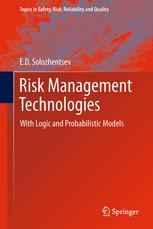

Most ebook files are in PDF format, so you can easily read them using various software such as Foxit Reader or directly on the Google Chrome browser.
Some ebook files are released by publishers in other formats such as .awz, .mobi, .epub, .fb2, etc. You may need to install specific software to read these formats on mobile/PC, such as Calibre.
Please read the tutorial at this link: https://ebookbell.com/faq
We offer FREE conversion to the popular formats you request; however, this may take some time. Therefore, right after payment, please email us, and we will try to provide the service as quickly as possible.
For some exceptional file formats or broken links (if any), please refrain from opening any disputes. Instead, email us first, and we will try to assist within a maximum of 6 hours.
EbookBell Team

5.0
80 reviewsThis book presents intellectual, innovative, information technologies (I3-technologies) based on logical and probabilistic (LP) risk models. The technologies presented here consider such models for structurally complex systems and processes with logical links and with random events in economics and technology.
The volume describes the following components of risk management technologies: LP-calculus; classes of LP-models of risk and efficiency; procedures for different classes; special software for different classes; examples of applications; methods for the estimation of probabilities of events based on expert information. Also described are a variety of training courses in these topics.
The classes of risk models treated here are: LP-modeling, LP-classification, LP-efficiency, and LP-forecasting. Particular attention is paid to LP-models of risk of failure to resolve difficult economic and technical problems. Amongst the discussed procedures of I3-technologies are the construction of LP-models, LP-identification of risk models; LP-risk analysis, LP-management and LP-forecasting of risk.
The book further considers LP-models of risk of invalidity of systems and processes in accordance with the requirements of ISO 9001-2008, LP-models of bank operational risks in accordance with the requirements of Basel-2, complex risk LP-models for preventing ammunition depot explosions, enterprise electric power supply systems, debugging tests of technical systems, etc. The book also considers LP-models of credit risks, securities portfolios, operational risks in banking, conteraction of bribes and corruption, etc.
A number of applications is given to show the effectiveness of risk management technologies. In addition, topics of lectures and practical computer exercises intended for a two-semester course “Risk management technologies” are suggested.